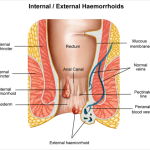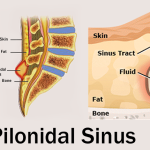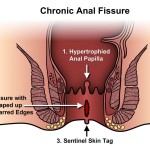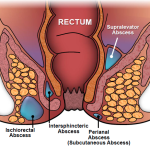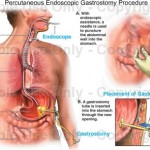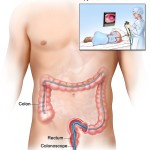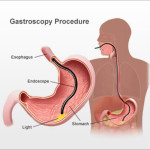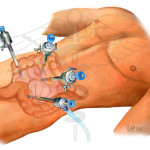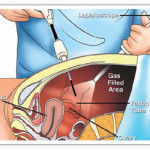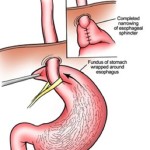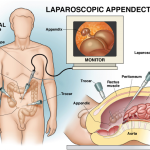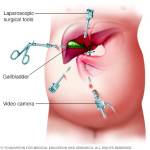Laparoscopic Appendectomy
What is the Appendix?
The appendix produces a bacteria destroying protein called immunoglobulins, which help fight infection in the body. Its function, however, is not essential. People who have had appendectomies do not have an increased risk toward infection. Other organs in the body take over this function once the appendix has been removed.
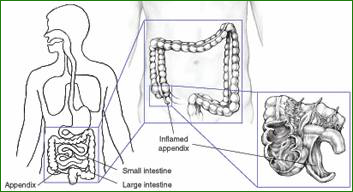
What is Appendicitis and what causes it?
Appendicitis is a sudden inflammation of the appendix. Although the appendix does not seem to serve any purpose, it can become diseased and, of left untreated, can burst, causing infection and even death. The cause of appendicitis is usually unknown. Appendicitis may occur after a viral infection in the digestive tract or when the tube connecting the large intestine to the appendix is blocked or trapped by stool. It is thought that blockage of the opening of the appendix into the bowel by a hard, small stool fragment causes inflammation and infection of the appendix (appendicitis). This inflammation can cause infection, blood clot, or rupture of the appendix. The infected appendix then must be surgically removed (emergency appendectomy) before a hole develops in the appendix and the infection spreads to the abdominal space (peritonitis).

What are the symptoms of Appendicitis?
- Abdominal pain – pain may begin in the upper-middle abdomen then develop to sharp localised pain
- Abdominal pain may be worse when walking or coughing
- Fever usually occurs within several hours
- Loss of appetite
- Nausea and vomiting
- Constipation
- Rectal tenderness
- Chills and shaking
If you have any of these symptoms, see a doctor immediately. Appendicitis is considered to be an emergency because of the risk of rupture, which may happen as soon as 48 to 72 hours after symptoms begin.
How is Appendicitis treated?
The best treatment for appendicitis is to surgically remove the appendix. Mild appendicitis may sometimes be cured with antibiotics. More serious cases are treated with surgery, called an appendectomy or appendicectomy. Doctors either use an ‘open’ technique or a minimally invasive approach to remove the appendix.
What is a Laparoscopic Appendectomy?
The laparoscopic (minimally invasive) technique involves making several tiny cuts in the abdomen and inserting a miniature camera and find laparoscopic instruments. The surgeon then removes the appendix with the instruments. This technique avoids the need to make a large incision in the abdomen and thus reduces post-operative pain and speeds up the recovery process.
What are the benefits of Laparoscopic Appendectomy?
Most cases of acute appendicitis can be treated laparoscopically. Common advantages are:
- Less post-operative pain
- Shorter hospital stay
- Faster recovery and return to normal activities
- May result in a quicker return to normal bowel function
- Less post-operative complications
- Minimally sized incisions/scars resulting in better cosmetic results.
In most cases, patients can be discharged within 24 – 36 hours after surgery. By contrast, the hospital stay is approximately 2 – 5 days for an open procedure.
Suitability for Laparoscopic Appendectomy
Although laparoscopic appendectomy has many benefits, it is not appropriate for some patients. Early, non-ruptured appendicitis usually can be removed laparoscopically, however, it is more difficult to perform if there is severe infection or the appendix has ruptured.
Patients with cardiac diseases and COPD (Chronic Obstructive Pulmonary Disease) would not be good candidates for laparoscopic surgery. In addition, laparoscopic appendectomy is not recommended for those with pre-existing conditions.
Laparoscopic appendectomy may also be more difficult in patients who have had previous abdominal surgery and for obese surgery. Elderly patients may be at increased risk of complications with regards to general anaesthesia. A traditional, open procedure using a larger incision may be more appropriate to remove the infected appendix.
Every patient is evaluated on an individual basis to determine the most appropriate type of surgery to perform.
What should I expect after Surgery?
After the operation, it is important to follow your doctor’s instructions. Although many people feel better after a few days, it is important to remember that your body needs time to heal.
- You aretly, as able. This will help reduce the risk of blood clots developing in your legs (deep vein thrombosis).
- You will probably be able to get back to most of your normal daily activities within 1 – 2 weeks following surgery. These activities include showering, driving, walking upstairs, and working.
- If you have prolonged pain or getting no relief from the prescribed medication, you should inform your doctor.
What complications can occur?
As with all operations, there are risks and complications can occur. However, the risk of these complications occurring is no higher than if the operation was done via the open technique.
Complications that can arise include:
- Bleeding.
- Infection
- Removal of normal appendix
- A leak at the edge of the colon where the appendix was removed
- Injury to other organs in the abdominal cavity such as the small intestine, ureter, or bladder
- Blood clot in the lungs (pulmonary embolism).
- It is important for you to recognise the early signs of possible complications. Contact your doctor if you have severe abdominal pain, fever, chills or rectal bleeding.
When to call your Doctor
It is important to call your doctor if you develop any of the following symptoms:
- Persistent fever over 101 degrees (39 C)
- Bleeding
- Increasing abdominal swelling
- Pain that is not relieved by medication
- Nausea and/or vomiting
- Persistent cough or shortness of breath
- Pus from wound site
- Any redness surrounding your wound as this could be a sign of infection
- You are unable to tolerate fluids and diet.

